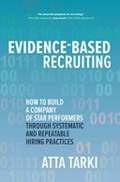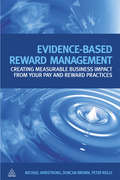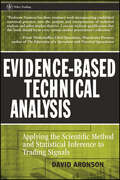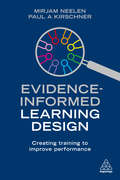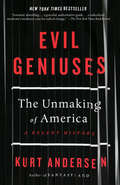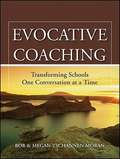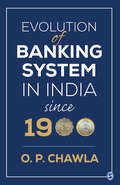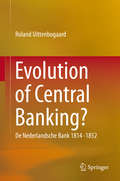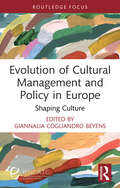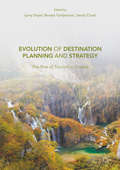- Table View
- List View
Evidence-Based Positive Psychological Interventions in Multi-Cultural Contexts
by Llewellyn Ellardus Van Zyl Sebastiaan Rothmann Sr.This volume presents clearly defined and described evidence-based positive psychology interventions (PPIs), which have been validated in multi-cultural contexts. It discusses validated PPIs which have been shown to have a significant impact in both clinical and real-world settings. From the late 1990s, there has been an upsurge in popular psychological “self-help” publications drawing from processes and principles of positive psychology. These publications are based on clinically validated PPI studies and translated in a “consumer friendly” manner. However, in these popular works the intervention methods are significantly altered from the original forms, and the contexts of the consumers are meaningfully different from those of the original study populations, the impact on outcome variables are often misinterpreted or over-inflated, and incorrect outcome variables are targeted. Original research articles also do not extensively discuss the content of the interventions, but merely present short descriptions of the PPI. As such, the intervention content cannot accurately be translated into practice. Hence, the need for this volume which discusses in depth how validated PPIs in various multi-cultural contexts work in both clinical and real-world settings.
Evidence-Based Recruiting: How To Build A Company Of Star Performers Through Systematic And Repeatable Hiring Practices
by Atta TarkiDevelop and execute systematic, best-in-class hiring practices to seize—and hold—the competitive edge in your industry <p><p> Defending your business from the competition through regulations, differentiated technologies, brand recognition, and other methods is no longer a sustainable competitive advantage. In today’s fast-paced, ever-changing business environment, you must take an offensive stance to keep your competitors at bay. And this groundbreaking guide provides the inspiration, the know-how, and the tools you need to achieve it. <p> This book guides you through the process of designing and implementing a data-driven hiring strategy that will secure your business for the foreseeable future. Revealing how today’s top innovators—including Netflix and Google—dominate their industries, it shows how you can do the same by implementing systematic and repeatable processes that lead to better, more consistent hiring outcomes. <p> Data and analytics have been reshaping countless industries as they turn from anecdotal to evidence-based practices. The recruiting and hiring processes, however, have been intuition-based. That changes today. Evidence-Based Recruiting introduces an entirely new approach—one that relies on irrefutable facts and data, enabling you and your organization to thrive in the new era of talent acquisition.
Evidence-Based Reward Management: Creating Measurable Business Impact from Your Pay and Reward Practices
by Michael Armstrong Duncan Brown Peter ReillyEvidence-Based Reward Management presents an analysis of the current failure of organisations to assess the effectiveness of pay and reward practices. It considers the reasons for this and outlines the damaging consequences of it. By examining recent developments in human capital information and measurement it looks at how HR can construct effective reward for improved performance, both for the individual and organization. The authors present the tools and techniques which can be applied to practice evidence-based reward management including a 4 step model, which sets strategic goals, reviews current policies, looks at how to pilot and make changes and improvements and explains how to monitor and adapt on an ongoing basis.
Evidence-Based Technical Analysis
by David AronsonEvidence-Based Technical Analysis examines how you can apply the scientific method, and recently developed statistical tests, to determine the true effectiveness of technical trading signals. Throughout the book, expert David Aronson provides you with comprehensive coverage of this new methodology, which is specifically designed for evaluating the performance of rules/signals that are discovered by data mining.
Evidence-Creating Medicine: Designing for Learning
by Richard BohmerThis chapter was originally published as chapter 6 of "Designing Care: Aligning the Nature and Management of Health Care."
Evidence-Informed Learning Design: Creating Training to Improve Performance
by Paul A. Kirschner Mirjam NeelenLearning and Development (L&D) programmes are too often based on fads, the latest trends or learning designers' personal preferences without critical evaluation. Evidence-Informed Learning Design will allow learning professionals to move away from this type of approach by showing them how to assess and apply relevant scientific literature, learning science research and proven learning techniques to design their training in a way that will make a measurable difference to employee performance and overall business success.Packed with tips, tools and examples, Evidence-Informed Learning Design enables L&D and training professionals to save both time and money by ensuring that efforts are focused on designing learning that's proven to be effective. Covering techniques like interleaving and self-directed and self-regulated learning, as well as debunking myths and fallacies in the field, it covers how best to test, measure and reinforce learning in both online, offline and face-to-face scenarios. To ensure that employees develop the skills the business needs to succeed and that the L&D function is recognised as adding true organizational value, this book is essential reading for anyone responsible for designing learning.
Evidence-based Practice for the Helping Professions: A Practical Guide with Integrated Multimedia
by Leonard E. GibbsPractitioners in the helping professions make life-affecting judgments and decisions. This new integrated learning package seeks to improve practice reasoning through principles of logical thinking and evidence-based practice.
Evidenzbasierter Wirtschaftsunterricht: Jahresband der Deutschen Gesellschaft für Ökonomische Bildung 2024 (Schriften der Deutschen Gesellschaft für Ökonomische Bildung)
by Dirk Loerwald Nils GoldschmidtIm Kontext von Unterrichtsqualität wird in den vergangenen Jahren zunehmend gefordert, dass empirische Befunde aus Fachdidaktik und Bildungsforschung für die Gestaltung von Unterricht zugrunde gelegt werden. Lehrkräfte sollen Unterricht evidenzbasiert planen, durchführen und auswerten. Mit evidenzbasiertem Unterricht ist die Hoffnung verbunden, dass die Qualität von Lehr-Lernprozessen unter Rückgriff auf abgesicherte empirische Befunde verbessert werden kann. Einschlägige wissenschaftliche Erkenntnisse und bewährte Theorien sollen bei den fachlichen und fachdidaktischen Entscheidungen von Lehrkräften Berücksichtigung finden. Im Rahmen des Tagungsbandes werden die Potenziale und Grenzen von evidenzbasiertem Wirtschaftsunterricht in den Blick genommen. Es wird dargelegt und diskutiert, welche Erkenntnisse im Unterrichtsalltag, in der Ausbildung von Lehrkräften und/oder in der Bildungspolitik zum Tragen kommen. Dazu gehört auch die Auseinandersetzung mit den Anforderungen an empirische Lehr-Lern-Forschung und fachdidaktische Entwicklungsforschung in der ökonomischen Bildung und dem Wissens- und Erkenntnistransfer von Hochschulen in die schulische Praxis.
Evil Corporations: Law, Culpability and Regulation
by Penny CroftsThis book elaborates and interrogates the idea of evil corporations from a diverse range of disciplines.There has long been awareness of systemic harms inflicted by corporations, but this awareness has rarely led to any effective legal means to prevent and/or respond adequately to them. Lawyers and legal theorists appear to be stuck asking the same questions, and giving the same ineffective answers. Part of the problem, this book maintains, is the relative lack of theoretical interrogation into the nature of corporations as responsible, moral agents. To break this stasis, this book draws upon philosophies of wickedness in order to ask whether or not corporations are, or can be, evil. With contributions from a range of different disciplines, including law, cultural theory, theology, and philosophy, it offers a novel account of how and why corporate wrongs are caused, whilst exploring the extent to which the legal system itself facilitates such wrongdoing.The book targets a broad international audience with research interests in corporate crime. This will be of particular interest to those within the legal discipline, including corporate law, criminal law, corporate crime and law and humanities scholars.Chapter 9 of this book is freely available as a downloadable Open Access PDF at http://www.taylorfrancis.com under a Creative Commons Attribution-Non Commercial-NoDerivatives (CC-BY-NC-ND) 4.0 license.
Evil Geniuses: The Unmaking of America: A Recent History
by Kurt AndersenWhen did America give up on fairness? The New York Times bestselling author of Fantasyland tells the epic history of how America decided that big business gets whatever it wants, only the rich get richer, and nothing should ever change—and charts a way back to the future. <P><P>During the twentieth century, America managed to make its economic and social systems both more and more fair and more and more prosperous. A huge, secure, and contented middle class emerged. All boats rose together. But then the New Deal gave way to the Raw Deal. Beginning in the early 1970s, by means of a long war conceived of and executed by a confederacy of big business CEOs, the superrich, and right-wing zealots, the rules and norms that made the American middle class possible were undermined and dismantled. The clock was turned back on a century of economic progress, making greed good, workers powerless, and the market all-powerful while weaponizing nostalgia, lifting up an oligarchy that served only its own interests, and leaving the huge majority of Americans with dwindling economic prospects and hope. <P><P>Why and how did America take such a wrong turn? <P><P> In this deeply researched and brilliantly woven cultural, economic, and political chronicle, Kurt Andersen offers a fresh, provocative, and eye-opening history of America&’s undoing, naming names, showing receipts, and unsparingly assigning blame—to the radical right in economics and the law, the high priests of high finance, a complacent and complicit Establishment, and liberal “useful idiots,” among whom he includes himself. <P><P>Only a writer with Andersen’s crackling energy, deep insight, and ability to connect disparate dots and see complex systems with clarity could make such a book both intellectually formidable and vastly entertaining. And only a writer of Andersen&’s vision could reckon with our current high-stakes inflection point, and show the way out of this man-made disaster. <P><P><b>A New York Times Bestseller</b>
Evil Plans
by Hugh MacleodThe acclaimed author of Ignore Everybody is back with more irreverent wisdom, wit, and original cartoons. "It has never been easier to make a great living doing what you love. But to make it happen, first you need an EVIL PLAN. Everybody needs to get away from lousy bosses, from boring, dead-end jobs that they hate, and ACTUALLY start doing something they love, something that matters. Life is short. " -Hugh MacLeod Freud once said that in order to be truly happy people need two things: the capacity to work and the capacity to love. Evil Plans is about being able to do both at the same time. The sometimes unfortunate side effect is that others will hate you for it. MacLeod's insights are brash, wise, and often funny. .
Evil: Radovan Karadzic--Understanding This Type of Bad Leadership
by Barbara KellermanWhen leaders commit atrocities and still stay in power for years on end, their followers are anesthetized, inflamed, or terrorized - or they are in some way rewarded. A very powerful example is that of Radovan Karadzic, the leader responsible for ethnic cleansing in Bosnia. While he made the orders, many were only too eager to fall into line. Through his story, this chapter illustrates how this type of leadership wins the complicity of followers.
Evive Health and Workplace Influenza Vaccinations
by John BeshearsEvive Health is a company that manages communication campaigns on behalf of health insurance plans and large employers. Using big data techniques and insights from behavioral economics, Evive deploys targeted and effective messages that improve individuals' health behaviors. This case follows Prashant Srivastava, Evive's Chief Operating Officer, and Jennifer Lindner, Evive's Creative Director, as they design a messaging strategy for promoting influenza vaccination at the free workplace clinics of a large utility company.
Evocative Coaching
by Megan Tschannen-Moran Bob Tschannen-MoranThere?s a lot of conversation about how to make schools better. Unfortunately, the nature of those conversations often makes things worse. Evocative Coaching: Transforming Schools One Conversation at a Time maps out a way to change that. By taking a teacher-centered, no-fault, strengths-based approach to performance improvement, the Evocative Coaching model generates the motivation and movement that enables teachers and schools to achieve desired outcomes and enhance quality of life. Viewed as a dynamic dance, the model is choreographed in four steps ? Story, Empathy, Inquiry, Design ? which are each laid out in its own chapter with powerful illustrative materials and end-of-chapter discussion questions to prompt further reflection.Bringing together the best research and wisdom in educational leadership and professional coaching, authors Bob and Megan Tschannen-Moran have developed a simple yet profound way of facilitating new conversations in schools through Story Listening, Expressing Empathy, Appreciative Inquiry, and Design Thinking. It?s an iterative process that moves beyond old ways of thinking, doing, and being. It?s an inspirational process that reinvigorates the passion for making schools better, one conversation at a time.This happens when coaches:give teachers our full, undivided attention;accept and meet teachers where they are right now, without making them wrong;ask and trust teachers to take charge of their own learning and growth;make sure teachers are talking more than we are;enable teachers to appreciate the positive value of their own experiences;harness the strengths teachers have to meet challenges and overcome obstacles;reframe difficulties and challenges as opportunities to learn and grow;invite teachers to discover possibilities and find answers for themselves;dialogue with teachers regarding their higher purpose for teaching;uncover teachers? natural impulse to engage with colleagues and students;assist teachers to draw up a personal blueprint for professional mastery;support teachers in brainstorming and trying new ways of doing things;maintain an upbeat, energetic, and positive attitude at all times;collaborate with teachers to design and conduct appropriate learning experiments;enable teachers to build supportive environments and teams;use humor to lighten the load; andinspire and challenge teachers to go beyond what they would do alone.Each chapter provides a research-based theory to support the strategies presented, and includes specific suggestions and anecdotes. The Evocative Coaching model makes coaching enjoyable by getting people to focus on what they do best, and it invites larger, more integral conversations so that people talk about their work in the context of other things they care about. Resting on strong, evidence-based practices, the Evocative Coaching model offers educators the help they need to meet the challenges of increased accountability and expectations. This model can also be used effectively by coaches and leaders in other organizational contexts.Table of Contents:Chapter 1: What Is Evocative Coaching?Chapter 2: Coaching PresenceLoop I: The No-Fault TurnChapter 3: Story ListeningChapter 4: Expressing EmpathyLoop II: The Strengths-Building TurnChapter 5: Appreciative InquiryChapter 6: Design ThinkingChapter 7: Aligning EnvironmentsChapter 8: Coaching ConversationsChapter 9: The Reflective CoachTo learn more about Evocative Coaching and to sign up for the Evocative Coach Training Program, visit www.SchoolTransformation.com.
Evolution and Advances in Computing Technologies for Industry 6.0: Technology, Practices, and Challenges
by Surbhi Bhatia Khan Srinath Doss Abdulmajeed Alqhatani Reddy, C. Kishor KumarThis book provides a comprehensive exploration of Industry 6.0, which marks the convergence of intelligent systems, machine learning (ML), deep learning, and human–robot collaboration (HRC) in various sectors. It focuses on how these technologies enable businesses to harness insights from vast datasets, optimize operations, forecast maintenance requirements, and mitigate outages. In this comprehensive book, the authors cover the major aspects of Industry 6.0, including the latest advances in technology, new applications, and the many challenges that accompany the process that is changing it. This book acts as a compass, guiding readers through the labyrinth of Industry 6.0, revealing the complex interactions between technologies, new applications, innovations, and business ecosystems. From a multidisciplinary perspective, the book explores the far‑reaching impact of Industry 6.0 on the business world, revealing its potential to increase productivity, improve decision‑making, and open new opportunities for development. Discusses the transformative impact of Industry 6.0 driven by the convergence of artificial intelligence (AI), ML, and the industrial internet of things (IIoT) in manufacturing Explores the transformative potential of HRC in modern manufacturing, emphasizing the ability of HRC to boost productivity, flexibility, and safety Compares several service models in cloud computing, with a focus on private, public, and community cloud deployment methods Presents information about autism spectrum disorder (ASD) in children and the advanced technology of convolutional neural networks used to detect autism in children Describes the accurate diagnosis of Alzheimer’s disease through integrating state‑of‑the‑art technologies, especially deep learning Focuses on digital adaptation in India’s agricultural sector, especially Uttar Pradesh, highlighting challenges and prospects Presents a visionary leap into Agriculture 6.0, where technology and tradition converge for sustainable farming solutions Provides the mitigation strategies for climate change over multiple locations Explores the transformative impact of recent computational intelligence advancements in vehicle surveillance and recognition, particularly through CCTV analysis Focuses on the exploration and development of a supply chain network design (SCND) model of milk products This book will be of interest to researchers, academics, practitioners, technology providers, undergraduate and postgraduate students, scholars, consultants, advisors, and doctors. It can be used by undergraduate and postgraduate students pursuing Industry 6.0 programs in computer science and engineering across the globe.
Evolution and Design of Institutions (Routledge Studies in Global Competition)
by Christian Schubert Georg Von WangenheimThis book comprises nine papers approaching designed institutions and their interplay with spontaneous institutions from various angles. While the evolution of spontaneous institutions is quite well understood in economic thinking, the development of consciously designed institutions has been examined much less. In new institutional economics, public choice, and law and economics the interaction between changing preferences and spontaneously evolving institutions on the one hand and the evolution of designed institutions (as, e.g., legal systems) on the other hand has largely been ignored. A number of top class international contributors have been assembled to study this phenomenon including Viktor Vanberg, Bruno Frey, Elinor Ostrom and Francesco Parisi.
Evolution and Performance of Exchange Rate Regimes
by Kenneth Rogoff Robin Brooks Ashoka ModyA report from the International Monetary Fund.
Evolution and Revolution as Organizations Grow
by Larry E. GreinerThe influence of history on an organization is a powerful but often overlooked force. Managers, in their haste to build companies, frequently fail to ask such critical developmental questions as, Where has our organization been? Where is it now? and What do the answers to these questions mean for where it is going? Instead, when confronted with problems, managers fix their gaze outward on the environment and toward the future, as if more precise market projections will provide the organization with a new identity. In this HBR Classic, Larry Greiner (professor of management and organization at the University of Southern California's Marshall School of Business) identifies a series of developmental phases that companies tend to pass through as they grow. He distinguishes the phases by their dominant themes: creativity, direction, delegation, coordination, and collaboration. Each phase begins with a period of evolution, steady growth, and stability, and ends with a revolutionary period of organizational turmoil and change. The critical task for management in each revolutionary period is to find a new set of organizational practices that will become the basis for managing the next period of evolutionary growth. Those new practices eventually outlast their usefulness and lead to another period of revolution. Managers therefore experience the irony of seeing a major solution in one period become a major problem in a later period. Originally published in 1972, the article's argument and insights remain relevant to managers today. Accompanying the original article is a commentary by the author updating his earlier observations.
Evolution of Austrian Economics: From Menger to Lachmann (Routledge Studies in the History of Economics)
by Sandye Gloria-PalermoThis book argues, against the dominant orthodoxy in the history of economic thought, for the originality of Carl Menger's contribution to the development of the Austrian school of economics. Situating the evolution of Menger's thought in the tradition of classical political economy, the author documents the emergence of a Mengerian logic and its contribution to the formation of a distinctly Austrian tradition of economics. In its bold elucidation of the shaping of a tradition in economic thought, Tradition and Innovation in Austrian Economics provides a fresh and challenging perspective on the Austrian school which will be of interest to researchers in Austrian economics and the history of economic thought.
Evolution of Banking System in India since 1900
by O. P. ChawlaEvolution of Banking System in India since 1900 presents a detailed analysis of the evolution, growth and development of the Indian banking system in the last 117 years, from 1900 to 2017. The book focuses on major events that have significantly impacted the banking system to change the course of its history. It covers major policy, structural, regulatory and legislative changes that formed the background as well as the springboard of the working of banks, followed by a detailed analysis of the significant financials. It also uncovers the most significant events and developments of scheduled commercial banking, which has evolved from a small unorganized system to a technology-oriented regulated one.
Evolution of Central Banking?
by Roland UittenbogaardThe book analyses the establishment of De Nederlandsche Bank and its early development as a case study to test competing theories on the historical development of central banking. It is shown that the establishment of DNB can be explained by both the fiscal theory and the financial stability theory. Later development makes clear that the financial stability role of DNB prevailed. DNB´s bank notes were not forced onto the public and competition was fierce. A prudent and independent stance was necessary to be able to play its intended role. This meant that DNB played a modest role in the Amsterdam money market until 1852. By 1852 it had established itself to become the central bank. By then its bank notes had become generally accepted and it could start to operate as a reserve bank. Also the market context had changed dramatically, its competitors had been driven out of the market and several credit institutions had become customers of DNB. "On the occasion of the Nederlandsche Bank's 200th Anniversary, it is good to have a new, and an extremely good, history of its founding and first fifty years of operation. The only previous account of this period of the DNB's history was legalistic and did not sufficiently place the Bank´s development in its wider context. Uittenbogaard's book provides a much broader, and better, story of the personnel, economics, and finance of the DNB at this juncture. " - Charles Goodhart, LSE.
Evolution of Competition Laws and their Enforcement: A Political Economy Perspective (Routledge Studies In Global Competition Ser.)
by Pradeep S. MehtaThis edited volume identifies the various country specific factors that warrant changes in the design and implementation of competition laws. The book covers case studies of nine countries of differing sizes and at varying stages of economic development, that have at one stage or another repealed extant competition laws for new ones, and seeks to examine the motivations and contexts under which this was done. The countries examined include the Czech Republic, Hungary, India, Ireland, Poland, Serbia, South Africa, Tanzania and the UK. Tracing the evolution of competition regimes in the countries covered, the book provides lessons for countries still in the process of forming their competition regimes. The contributions show that the road to strong competition regimes is seldom smooth, and that social, economic and political factors in the country hugely impact on the pace and effectiveness of competition reforms. The volume also addresses the issue of when the development of competition policies and laws can be seen to be in conflict with national development strategies.
Evolution of Corporate Financial Reporting (Routledge Library Editions: Accounting)
by T. A. Lee R. H. ParkerThis book explores certain contemporary problems of accounting through the eyes and pens of historians. Many accounting problems are not new ones and it is therefore important to understand their history and development through the ages. This book places twentieth century studies in context and provides clues to possible solutions. The focus of this book is on companies and their financial reports and will be of use to students of economic and business history who wish to provide themselves with an accounting background in relation to the financial reports of companies they may be studying.
Evolution of Cultural Management and Policy in Europe: Shaping Culture (ENCATC Advances in Cultural Management and Policy)
by GiannaLia Cogliandro BeyensSince the 1990s, cultural management and policy in Europe have undergone transformative changes. This insightful book offers a comprehensive journey through that evolution, blending historical insights with an analysis of current trends to illuminate the future of the field.The book also highlights the pivotal role of cultural networks in shaping and advancing culture, creativity, and heritage, bridging academic inquiry with real-world practice. Through a focused case study on the European Network on Cultural Management and Policy, ENCATC, it provides a unique perspective on how networks shape policy and management strategies across Europe.A must-read for scholars, practitioners, policymakers, and students, this book delivers key insights into the ever-changing landscape of arts and cultural management.
Evolution of Destination Planning and Strategy
by Larry Dwyer Renata Tomljenović Sanda ČorakThis book deals broadly with tourism planning and development from the perspective of Croatia, a major Adriatic tourism destination which is fast becoming one of the most popular vacation spots in the European Union. With the recent accession of Croatia to the EU, Croatia is undergoing a rapid political and economic transition and generating scholarly interest in the country's primary, secondary, and tertiary industries. This book examines the country's long history and thriving success in the tourism industry through issues of destination image and identity, management challenges, economic impact, and how to attract tourists in the midst of extreme political changes. The book explores the implications of policy decisions on product development and takes a theoretically sound approach to destination planning and problem-solving in Croatia. Its timely view of Croatian national tourism policy and the broader Adriatic/Mediterranean region makes this book of interest to all scholars, students, and practitioners engaged in various aspects of destination development planning and management.

